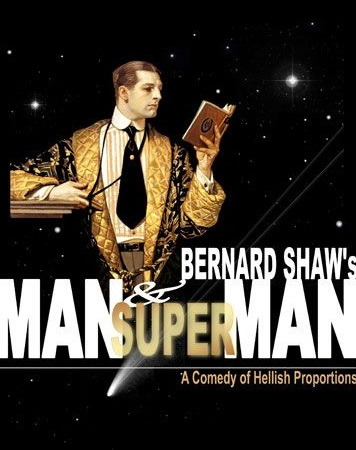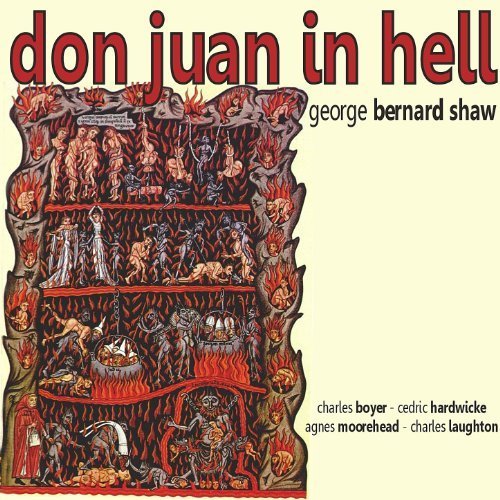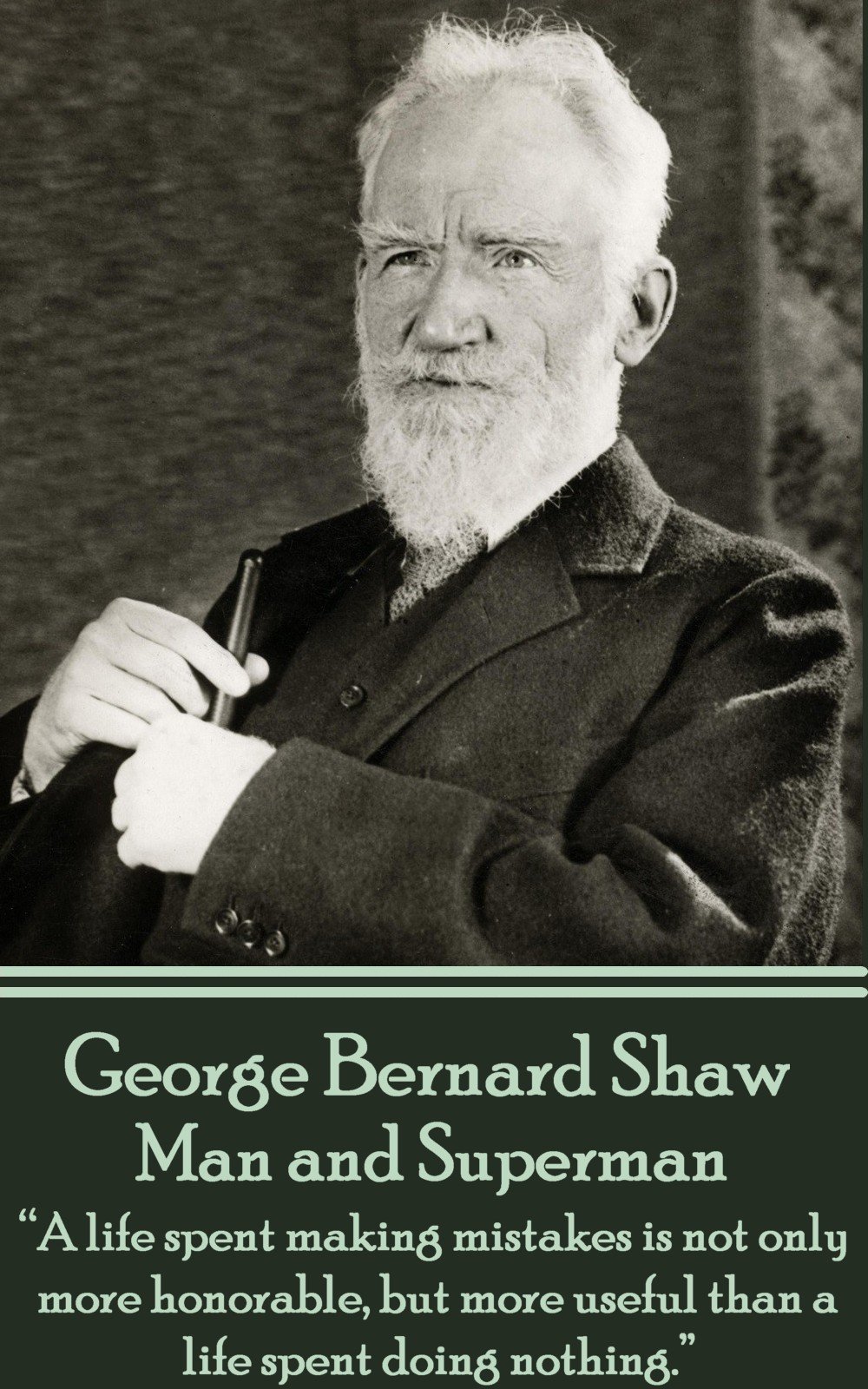Man and Superman
George Bernard Shaw
George Bernard Shaw

Man and Superman is a four-act drama written by George Bernard Shaw in 1903. The series was written in response to calls for Shaw to write a play based on the Don Juan theme. Man and Superman opened at the Royal Court Theatre in London on 23 May 1905, but it omitted the third act. A part of the act, Don Juan in Hell
(Act 3, Scene 2), was performed when the drama was staged on 4 June
1907 at the Royal Court. The play was not performed in its entirety
until 1915, when the Travelling Repertory Company played it at the Lyceum Theatre, Edinburgh.
Although Man and Superman can be performed as a light comedy of manners Shaw intended the drama to be something much deeper, as suggested by the title.
This title comes from Friedrich Nietzsche's philosophical ideas about the "Übermensch" ("Superman").
The plot centers on John Tanner, a confirmed bachelor despite the pursuits of Ann Whitefield and her persistent efforts to make him marry her. Ann is referred to as "The Life Force" and represents Shaw's view that in every culture, it is the women who force the men to marry them rather than the men that take the initiative.
Although Man and Superman can be performed as a light comedy of manners Shaw intended the drama to be something much deeper, as suggested by the title.
This title comes from Friedrich Nietzsche's philosophical ideas about the "Übermensch" ("Superman").
The plot centers on John Tanner, a confirmed bachelor despite the pursuits of Ann Whitefield and her persistent efforts to make him marry her. Ann is referred to as "The Life Force" and represents Shaw's view that in every culture, it is the women who force the men to marry them rather than the men that take the initiative.
Summary
Mr. Whitefield has recently died, and his will indicates that his daughter Ann should be left in the care of two men, Roebuck Ramsden and Jack Tanner. Ramsden, a venerable old man, distrusts Jack Tanner, an eloquent youth with revolutionary ideas, saying "He is prodigiously fluent of speech, restless, excitable (mark the snorting nostril and the restless blue eye, just the thirty-secondth of an inch too wide open), possibly a little mad". In spite of what Ramsden says, Ann accepts Tanner as her guardian, though Tanner doesn't want the position at all. She also challenges Tanner's revolutionary beliefs with her own ideas. Despite Tanner's professed dedication to anarchy, he is unable to disarm Ann's charm, and she ultimately persuades him to marry her, choosing him over her more persistent suitor, a young man named Octavius Robinson.
List of characters
- Hector Malone, Sr., an elderly gentleman who has worked hard throughout his life to attain a high social status in which he now takes pride.
- Ann Whitefield, a young woman, graceful, somewhat enigmatic. She corresponds to the character Doña Ana in the Don Juan myth (in Act III, Shaw's stage direction refers to Doña Ana de Ulloa as "so handsome that in the radiance into which her dull yellow halo has suddenly lightened one might almost mistake her for Ann Whitefield").
- John Tanner, also called "Jack Tanner," a well-educated, well-spoken man who takes everything seriously, including himself; a "political firebrand and confirmed bachelor." Allegedly the descendant of Don Juan, as well as the modern representation of the Don Juan character (In Act III, Shaw notes Don Juan's resemblance to Tanner: "Besides, in the brief lifting of his face, now hidden by his hat brim, there was a curious suggestion of Tanner. A more critical, fastidious, handsome face, paler and colder, without Tanner’s impetuous credulity and enthusiasm, and without a touch of his modern plutocratic vulgarity, but still a resemblance, even an identity"). The very name "John Tanner" is an anglicisation of the Spanish name "Juan Tenorio," which is the full name of Don Juan.
- Violet Robinson, sister of Octavius Robinson. She has been secretly married to Hector Malone, Jr.
- Mrs. Whitefield, mother of Ann, and widow of the late Mr. Whitefield.
- Susan Ramsden, the spinster sister of Roebuck Ramsden.
- Hector Malone, Jr., an American gentleman who is secretly married to Violet Robinson.
- Octavius Robinson, an amiable young man who is in love with Ann Whitefield. Brother to Violet Robinson. He represents "Don Ottavio" from the Don Juan myth.
- Roebuck Ramsden, an aging civil reformer who was friend to the late Mr. Whitefield. He corresponds to the statue in the Don Juan myth, who is in turn the representation of the spirit of Don Gonzalo, the father of Doña Ana (in Act III, Shaw writes of The Statue, "His voice, save for a much more distinguished intonation, is so like the voice of Roebuck Ramsden").
- Mendoza, an anarchist who collaborates with Tanner. Mendoza is the "President of the League of the Sierra," a self-described brigand and a Jew. He corresponds to Shaw's conception of the Devil as he would be portrayed in the Don Juan myth (Shaw writes of "The Devil" in Act III: "A scarlet halo begins to glow; and into it the Devil rises, very Mephistophelean, and not at all unlike Mendoza, though not so interesting").
- Henry Straker, chauffeur with a cockney accent.
Interpretation and performances
Don Juan in Hell
The long third act of the play, which shows Don Juan himself having a conversation with several characters in Hell, is often cut. Charles A. Berst observes of Act III:
Paradoxically, the act is both extraneous and central to the drama
which surrounds it. It can be dispensed with, and usually is, on grounds
that it is just too long to include in an already full-length play.
More significantly, it is in some aspects a digression, operates in a
different mode from the rest of the material, delays the immediate
well-made story line, and much of its subject matter is already implicit
in the rest of the play. The play performs well without it.
Don Juan in Hell consists of a philosophical debate between Don Juan (played by the same actor who plays Jack Tanner), and the Devil, with Doña Ana (Ann) and the Statue
of Don Gonzalo, Ana's father (Roebuck Ramsden) looking on. This third
act is often performed separately as a play in its own right, most
famously during the 1950s in a concert version, featuring Charles Boyer as Don Juan, Charles Laughton as the Devil, Cedric Hardwicke as the Commander and Agnes Moorehead as Doña Ana. This version was also released as a spoken word album on LP, but is yet to appear on CD. In 1974–1975, Kurt Kasznar, Myrna Loy, Edward Mulhare and Ricardo Montalban toured nationwide in John Houseman's reprise of the production, playing 158 cities in six months.
Ideas
Although Man and Superman can be performed as a light comedy of manners, Shaw intended the drama to be something much deeper, as suggested by the title, which comes from Friedrich Nietzsche's philosophical ideas about the "Übermensch".
The plot centres on John Tanner, author of "The Revolutionist's
Handbook and Pocket Companion", which is published with the play as a
58-page appendix. Both in the play and in the "Handbook" Shaw takes
Nietzsche's theme that mankind is evolving, through natural selection,
towards "superman" and develops the argument to suggest that the prime
mover in selection is the woman: Ann Whitefield makes persistent efforts
to entice Tanner to marry her yet he remains a bachelor. This is an explicit, intended reversal of Da Ponte's Don Giovanni; here Ann, representing Doña Ana, is the predator.
Ann is referred to as "the Life Force"
and represents Shaw's view that in every culture, it is the women who
force the men to marry them rather than the men who take the initiative. Sally Peters Vogt proposes, "Thematically, the fluid Don Juan myth becomes a favorable milieu for Creative Evolution," and that "the legend...becomes in Man and Superman the vehicle through which Shaw communicates his cosmic philosophy"
Productions
In 1977–1978 the RSC produced Man and Superman at London's Savoy Theatre.
In 1982, a television version with Peter O'Toole in the starring role was first broadcast in the United Kingdom.[16]
In 1996, to celebrate BBC Radio 3's 50th Anniversary, Sir Peter Hall directed an audio production with Ralph Fiennes as Jack Tanner, Judi Dench as Mrs. Whitefield, John Wood as Mendoza, Juliet Stevenson as Ann Whitefield, Nicholas Le Provost as Octavius Robinson and Jack Davenport as Hector Malone.
In 2015, London's National Theatre staged a production, with the "hell" sequence included, directed by Simon Godwin and starring Ralph Fiennes as Jack Tanner and Indira Varma as Ann Whitefield.

External links
- Man and Superman, an audio rendition of the play. https://archive.org/details/Man_and_Superman
- Man and Superman, digitized copy of the first edition from Internet Archive. - https://archive.org/details/mansupermancomed00shawrich
- Man and Superman at the Internet Broadway Database
- Review, photos and other information
- Read online at Project Gutenberg
- "The Revolutionist's Handbook and Pocket Companion", an appendix to Man and Superman (page images)
- "Old Time Radio". MP3 downloads of 1950 performance.


No comments:
Post a Comment